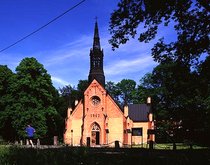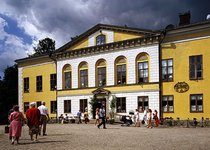Taxinge-Näsby
Taxinge-Näsby Castle was built in the empire style of the early 19th century. It stands on a promontory in Mälaren with a view across the Gripsholm bay. Taxinge Church has been rebuilt in neo-gothic style.
The history of Taxinge-Näsby starts in prehistoric time, and the first time it is mentioned in a written document is 1281. The document states that a brother of King Magnus Ladulås donated the village of Näsby to the cathedral at Strängnäs. One famous owner during the mediaeval period was Bo Jonsson Grip, seneschal of the realm, and right-hand man to King Albrekt av Mecklenburg. Bo Jonsson owned many properties and farms, and built Gripsholm Castle not far from Näsby. By the end of the mediaeval period, Näsby had been donated to the Carthusian monastery in Mariefred, only for Gustav Vasa to seize the village during the reformation.
In 1795, Näsby was purchased by merchant Joakim Daniel Wahrendorff, one of the most wealthy men in Sweden, and owner of many estates and farms, mines and mills.
Making money by oats
Näsby had by this time become a large estate, the third largest in Södermanland, and encompassed nearly the complete parish of Taxinge and parts of several others. Oats played the same role during the era of horse transport that oil plays today, and the owners of Näsby made a fortune from the export of oats to towns in England and Germany.
The current building, in imposing empire style, was built in the period 1806-1813 following a design of CG Gjörwell, and has not changed much since then. The wings are older, from 1740.
The castle has several gardens, where a Turkish pavilion and a Chinese pavilion, among other attractions, can be found.
The property is now owned by the municipality, which operates it as a facility for celebrations and conferences, with a café.
The growth of a community
Taxinge Church was originally built at the end of the 17th century, but was fully rebuilt in neo-gothic style in 1862-1863. The iron flèche is similar to the spire of Riddarholm Church in Stockholm: both were cast at Åkers styckebruk.
The 19th century saw the growth of a complete community here with school, church, shops, telegraph, steamboat pier and railway station. The estate was home to a sawmill, planing mill, smithy, brickworks, dairy and flour mill.
The rail station and the tracks are now used by the Östra Södermanland Museijärnväg (museum railway). A railcar runs between Läggesta and Taxinge-Näsby during the summer. The school is now in use as a daycare centre. The steamboat pier is used during the summer by the steamer Mariefred. The old grocery shop from the 1910s is used as a pub during the summer.
Links
The closest public transport is the SL stop at Taxinge.


